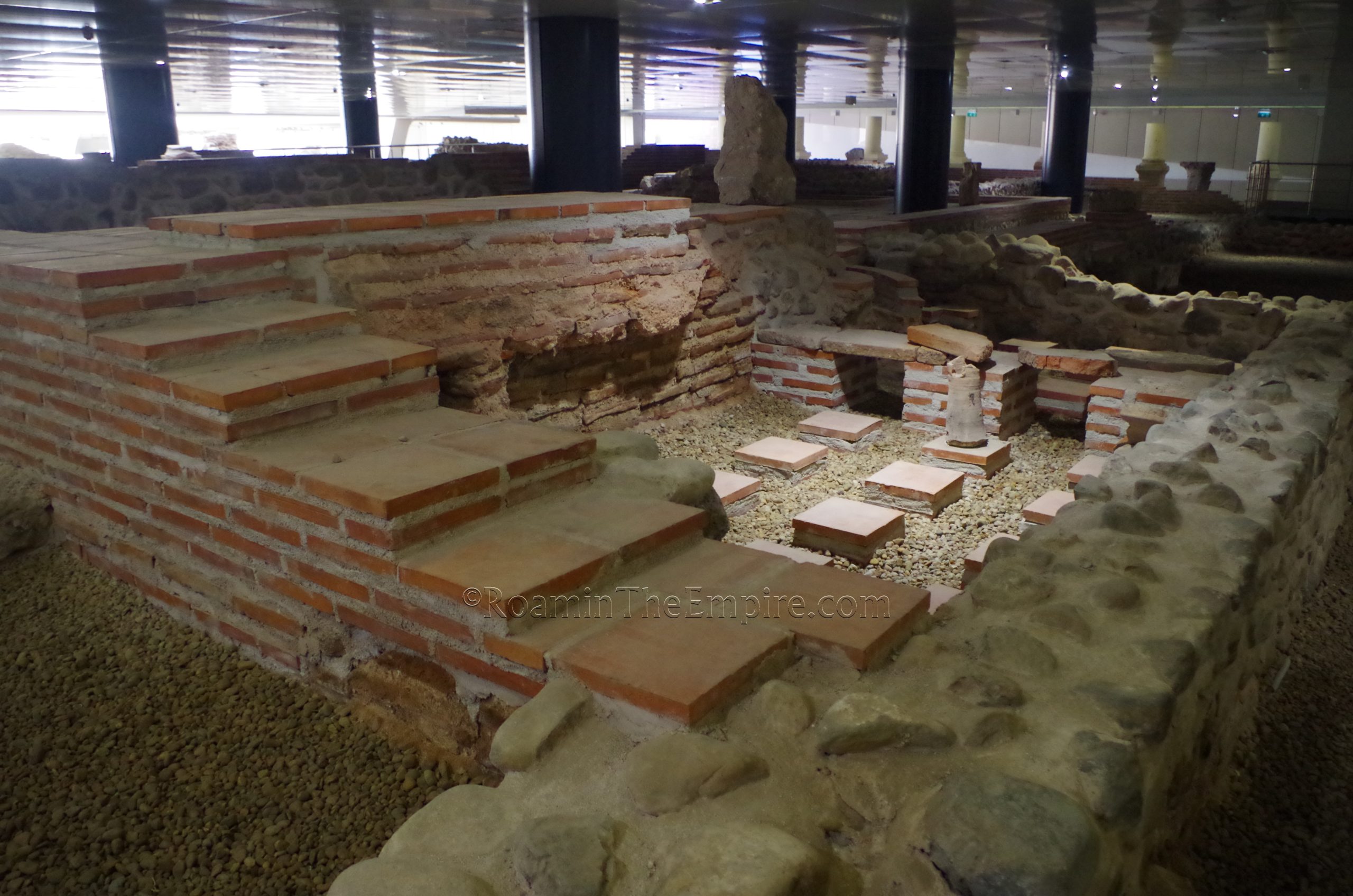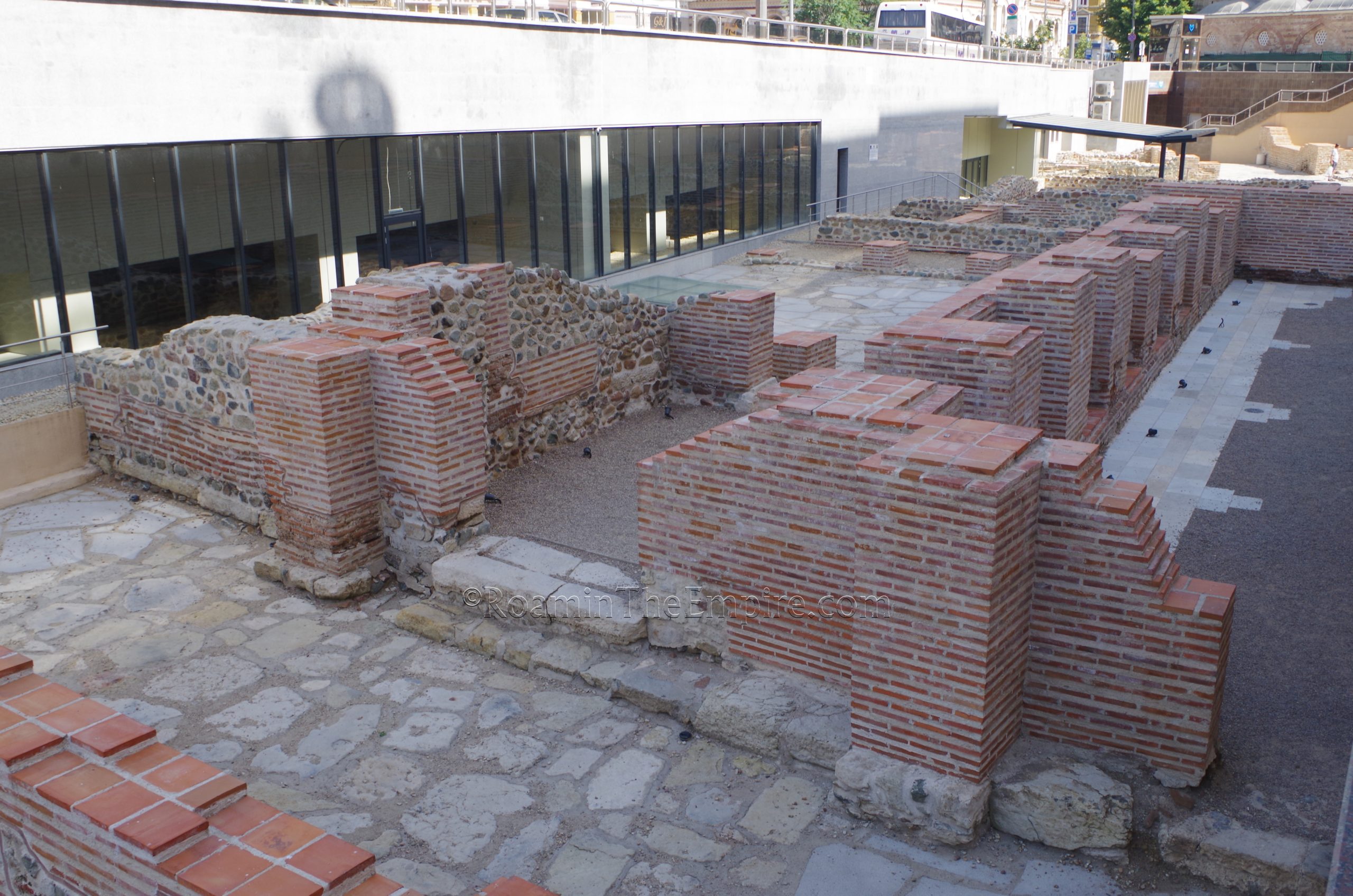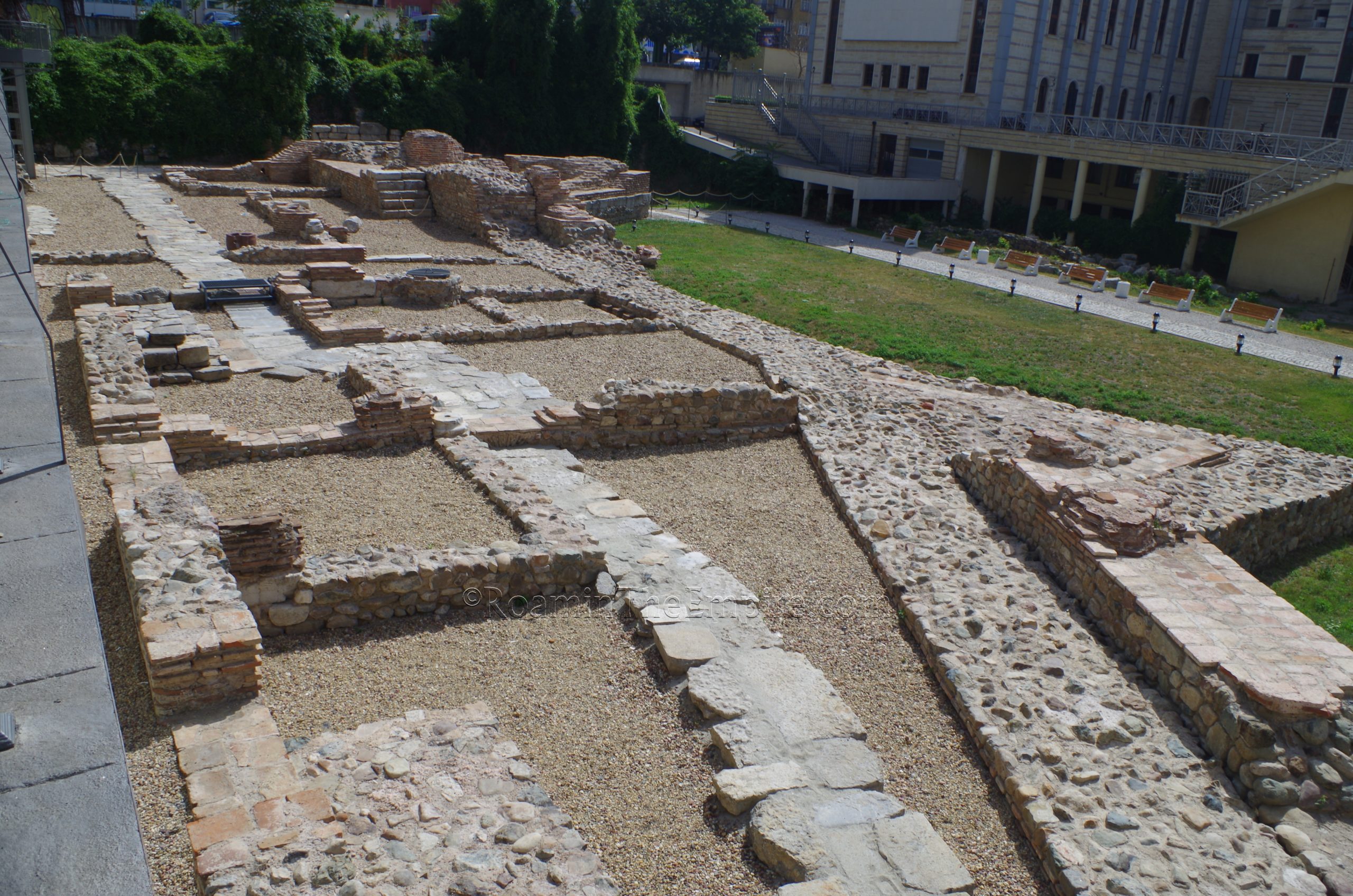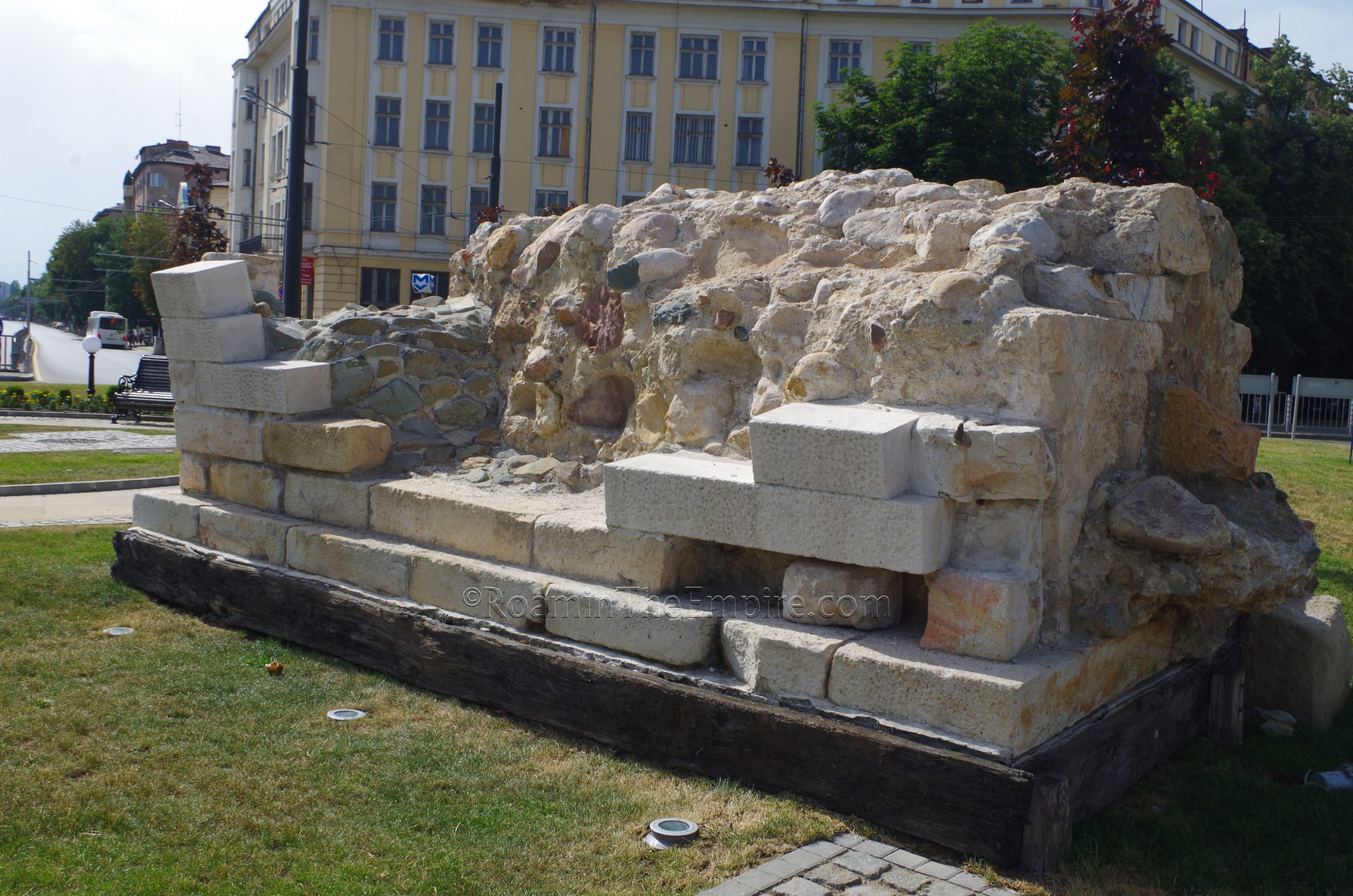
Out in front of the hotel that makes up the western part of the building complex enclosing the Church of St. Geroge, where we left off, is another set of excavations, the Sveta Nedelya Square excavations. These were ongoing when I visited in 2017, and seem to still be presently under excavation. Unfortunately, not much can be seen from ground level, most of the excavations are surrounded by a solid wall, though there are a few transparent windows to look through. As such, there wasn’t much to see, most of the excavations were covered when I visited. What remains here, though, is apparently the remains of a large public building originally constructed in the 2nd century CE and facing onto the cardo maximus. It was subsequently used until the 6th or 7th century CE. Due to the location in a public square, hopefully this will one day be accessible as part of the public archaeological displays in this part of town. There are some nice informational boards on the walls surrounding the excavations with English translations explaining the nature of the remains being uncovered.
From there, it’s a short walk across Boulevard Todor Alexandrov to perhaps the most significant (in terms of excavated area) set of remains in the city, the Ancient Serdica Archaeological Complex. There are a couple ways to access these remains, which are largely in a publicly accessible area with unrestricted access, and thus no admission or hours. I think the best place to start is at the southeastern part of the complex, which is accessible from the stairways leading down to the subterranean pedestrian area at the intersection of Boulevard Todor Alexandrov and Ploshtad Knyaz Aleksandar I, at the southeastern corner of the imposing government building that towers over Boulevard Todor Alexandrov.
The first point of interest at this extent of the archaeological area is the eastern gate of the city. Elements of both the interior and exterior gateways of the gate are remaining, as well as some of the adjacent walls, including the triangular fortification projecting off the exterior entry of the gate. The lower part of these fortifications, the larger ashlar blocks, were part of the circuit built by Marcus Aurelius between 177 CE and 180 CE. There’s even an inscription, in Greek, on display adjacent to the gate that attests to the construction of the walls upon order of Marcus Aurelius and also mentioning his co-emperor Commodus. The inscription was actually found at the western gate of the city, where it was likely mounted above the entrance. A subsequent improvement to the walls was made in the 4th century CE, some of which are also visible here, and then again during the reign of Justinian during the rebuilding of the city.

Leading westward from the east gate was the decumanus maximus, which is preserved to some degree in the path. Inside the east gate, some elements from the portico that would have lined the street are reconstructed along both sides. A little bit further on, on the south side of the decumanus maximus is a residential complex. Again, the reconstruction and conservation is very kind of heavy handed, and most of the brick used in this part of the complex looks to be modern. A path leads around it and some of the various elements of a residential building can be seen, including what appears to be an atrium as well as the remains of a hypocaust system. There is also another decumanus running along the southernmost part of this complex. The mosaics found in the building date to the 4th century CE.
Just past the residential complex, below one of the large domes that is visible from street level, is a small section of a cardo and an adjacent wall. This road, which was constructed a bit later than the decumanus maximus, is raised significantly above the ground level of that street. As such, though, some of the sewer line that ran under the road is visible. Past that are the remains of two more modern churches. First is some partial remains of a 16th to 19th century CE church, mostly the apse which has intact fresco decoration visible. Then after that, the medieval Church of St. Petka, which is where the archaeological area exits from the subterranean to open air.

At this point, the archaeological area then turns northward, the route once again passes over a small portion of the decumanus maximus before opening up on what is the very western extent of Insula 1. Like the other areas, there is again very heavy restoration. The southern part of the exposed insula contains a few rooms, one of which includes a room with a hypocaust system and channels in the floor, dated to the 4th century CE. The northern part of the insula seems to belong to a residence which has been called the Felix House, due to the presence of a mosaic decorated with the word. This too is dated to the 4th century CE through the 6th century CE. There are also some remains located to the west of the open air part that are enclosed in a building. At the time I visited in 2017, this was inaccessible, though it has apparently been opened to visitation since then.
Heading further north, there is another decumanus (dated to the 5th to 6th century CE) before the area passes to the so-called Insula 2 area. The primary remains in this part of the archaeological area are composed of the monumental so-called magistrate’s house. The present remains date to between the 4th and 6th century CE, though an earlier building dated to the 2nd and 3rd centuries CE occupied the space prior. This house belonged to the magistrates Arrius Pappos and Arrius Lucius, per an inscription found in that layer. Some remains from this earlier occupation period are exposed at various points. The monumental courtyard that made up the core of this building is visible, as well as a robust wall with outward facing niches that were part of a portico on the east side of the courtyard.

Another 5th to 6th century CE decumanus borders the northern part of the Magistrate’s House and then opens up into a residential and commercial area dating to the same period. The large cardo maximus then cuts into the area at an angle, relative to the decumani. The commercial-residential area is confined to the west of the cardo maximus, while a small portion of a 4th to 5th century CE bathing complex is present in the small area exposed to the east/northeast of the cardo maximus. All along this area, too, there are remains in the buildings to the west, but again, were inaccessible at the time. Throughout all of the Serdica complex, there are a number of informational signs in both English and Bulgarian.

Following the cardo maximus northward ends in the entrance to the Serdika II metro station, but, there are more remains inside the metro station. Immediately inside the station, visible through glass floors, sit the remains of a 1st century CE wooden wall; oak and beech beams crossed with smaller wooden branches. Farther on are the remains of the apse of an early Christian basilica dating to the 4th century CE. Some wood beams, left in situ in the floor, were also found associated with this structure. Adjacent to the basilica are some walls associated with a 2nd century CE Roman house. Of particular interest here is evidence of an eschara, a small ritual hearth, which has been left in situ. And finally, some more remains of the 2nd century CE Roman house, used and improved through the 4th century CE, including an internal courtyard are visible at the very interior of the station. The metro station presumably closes when the metro is not running, so, these may only be accessible during hours of operation for the metro.

A few blocks to the west is a park with the remains of the western gate of the city. This is a publicly accessible park with no admission, so it is open and can be visited at any time. Here, the remains of the foundations of the northern tower of the west gate along with a stretch of the walls north of the gate, including a triangular tower, have been uncovered. Part of the decumanus maximus, exiting through the western gate has also been excavated at two different depths; the 2nd to 4th century road as well as the later 5th and 6th century iteration of the road. Like the east gate, the foundations of this part of the wall date to the late 2nd century CE, but elements of the later walls, including the triangular tower, date to the 5th and 6th century CE. The interior part of the fortification walls (the east face) date to the earlier period, while the exterior face is the later addition. Some buildings of undetermined function have also been uncovered immediately inside the walls dating to the later periods of construction.
Heading back to the east is the Regional History Museum Sofia. It should be noted that at the opposite end Banski Square (the west side) from the museum is the Banya Bashi Masjid mosque, and a small excavation on the northeast side is often described as being a Roman baths. These remains, though, are from a later period and are not Roman. The Regional History Museum Sofia is located at Banski Square 1. The museum is open Tuesday through Sunday from 10:00 to 18:00 and closed on Mondays. Admission is 6 BGN.

As the name suggests, this is a history museum, and the vast majority of it is actually dedicated to post antique periods with very heavy emphasis on the formation of the Bulgarian state and the history of the last 300 years or so. There is, however, a modest section dedicated to archaeological finds. This mostly includes smaller items like ceramics, jewelry, and coins. There are a few fragments of larger statuary, but perhaps the most interesting piece is the lower half of a Mithraic tauroctony relief found nearby. The whole museum is interesting for what it is, and is worth the stop, but, in terms of the antiquities collection, there’s nothing spectacular or groundbreaking to see. Most objects and information includes an English translation. There is a small lapidary collection out in front of the museum.
About 50 meters to the northeast of the museum is the excavations of the so-called northeastern corner tower. As the name suggests, this was tower made up the northeast corner of Serdica’s fortifications. There’s no direct access like some of the other remains in the city, but, it is still in a public area, so the tower can be viewed at any time. Most of the fortifications that are visible date to the 5th century CE walls, but there are some foundations of the earlier 3rd century CE wall. In addition to the actual fortifications, there are also a few (heavily reconstructed) remains of some buildings on the interior side of the wall. A number of columns are also on display in an adjacent greenspace.

The last point is a little bit of a walk back out and up Boulevard Knyaginya Maria Luiza to the Lavaov Most, the Lion’s Bridge, spanning the Vladaya River. In antiquity, there was also a bridge spanning this river at this location, and on the north bank there is the remnant of a pillar from the bridge, which is dated to between the 4th and 6th century CE. Since this is in a publicly accessible area, there are no restrictions on visitation. An informational sign in Bulgarian and English is present on site.
It is also worth noting that there are some archaeological items in the National Museum of History located on the outskirts of town. It’s about 8 kilometers out from the city center, and I wasn’t able to make it there; public transport would have taken over an hour each way, and I didn’t have the opportunity. Like the history museum in town, though, the large majority of the collection seems to be later periods with the earlier material just kind of there to sort of round out the whole history of the area. The museum is open daily in the summer (April through October) from 9:30 to 18:00 and the rest of the year from 9:00 to 17:30. Admission is 10 BGN.
Sources:
Ammianus Marcelinus. Rerum Gestarum, 16.18.1, 31.16.
Cassius Dio. Historia Romana, 51.25.
Eutropius. Breviarium ab Urbe Condita, 9.22.
Grant, Michael. A Guide to the Ancient World: A Dictionary of Classical Place Names. New York: Barnes & Noble Books, 1997
Paunov, Evgeni I. “Roman Entertainment in Sеrdica-Sofia.” Minerva, vol. 19, no. 2, 2008, pp. 40–41.
Smith, William. Dictionary of Greek and Roman Geography. Walton & Murray, 1870.
Stillwell, Richard, William L. MacDonald, and Marian Holland. McAllister. The Princeton Encyclopedia of Classical Sites. Princeton, NJ: Princeton U Press, 1976.
Valeva, Julia (ed.), Emil Nankov (ed.), and Denver Graninger (ed.). A Companion to Ancient Thrace. West Sussex: Wiley Blackwell, 2015.


